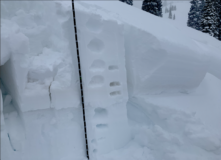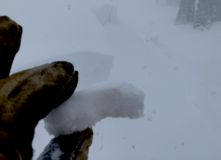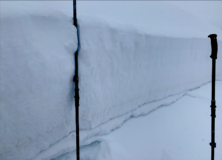Date of Observation: 02/23/2022
Name: Eric Murrow
Zone: Northwest Mountains
Route Description: Washington Gulch TH to Elkton area and lap near Coneys.
Observed avalanche activity: Yes
Avalanches: Numerous avalanches in upper Washington Gulch. Many slopes greater than 35 degrees on the north half of the compass ran naturally. Only observed 2 D2 size avalanches, but the terrain I was able to see were all relatively short hills. I remotely triggered a drifted southeast slope above Elkton from a couple hundred feet away while snowmobiling. Crowns ranged from 30cm to 80cm. The largest avalanche was the east bowl off Elkton Knob.
Weather: Cloudy skies with generally light SW winds (some moderate gusting). From 1 pm to 330 pm snowfall rates increased dramatically around S2 with brief periods up to S5.
Snowpack: At 300pm in Elkton, I measured 30 inches of storm snow with 2.4 inches snow water equivalent. Ski pen was around 12 inches and boot pen was nearly full storm depth. While traveling around I regularly produced moderate collapses and cracking with a few of the rumbling variety. On drifted features, it often took a slight bounce to produce the collapse; the stiffer the snow the further cracks and whumping traveled. We experienced even a few localized collapses in forested terrain near Coneys. The only slopes in this area that did not collapse and shoot cracks were south and southwest around 11k in elevation.
East and southeast slopes in this area had thin, soft melt/freeze crusts capping the facets below. The remotely-triggered avalanche from the drifted southeast slope had a 4cm melt/freeze crust that collapsed. Stability tests on east and southeast features produced easy and moderate propagating results.
The couple of south and southwest features I traveled across around 11,000 feet did not show signs of instability. Some cracking that ran up to a ski length, but it only broke down about 12 inches into the top of the storm snow. The south and southwest features I looked at had strong melt/forms to the ground beneath the new snowfall. Stability tests did not produce results on the interface between the old crust and the recent snow.
Photos:- A look at the crown of a natural avalanche on east aspect at 11k. A thin melt/freeze crust was capping the fist hard facets.
- An example of the thin crust capping the facets on east and southeast slopes in this area.
- The crown of the remotely-triggered avalanche from a southeast slope. Notice the 4cm thick crust at the bottom that failed and collapsed. This terrain feature is at 11k and previously drifted. Several crust were present from snow and wind earlier this week making for a complex mess of facets and crusts immediately below the storm snow.







